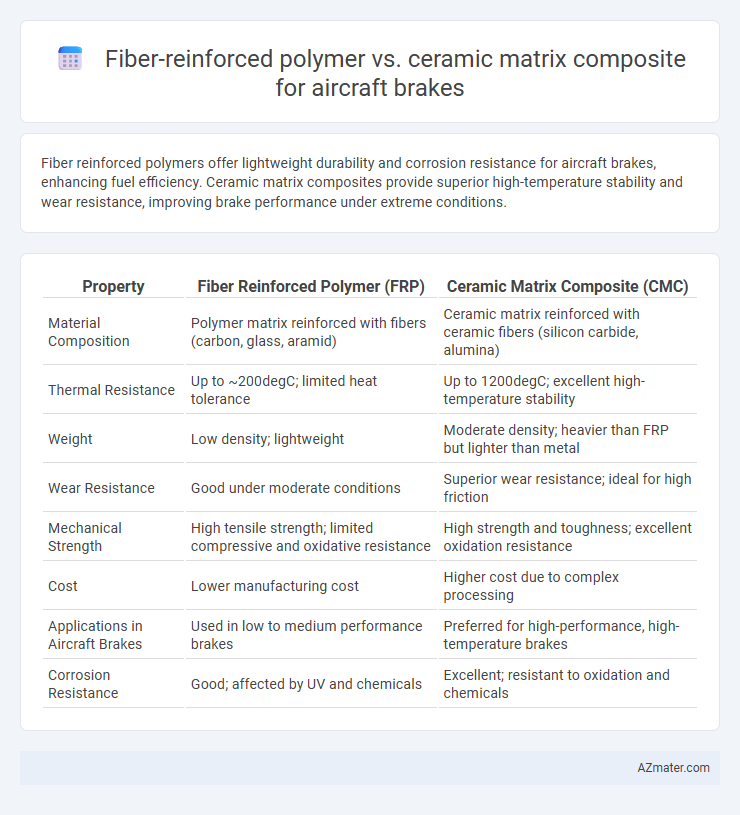Fiber reinforced polymers offer lightweight durability and corrosion resistance for aircraft brakes, enhancing fuel efficiency. Ceramic matrix composites provide superior high-temperature stability and wear resistance, improving brake performance under extreme conditions.
Table of Comparison
| Property | Fiber Reinforced Polymer (FRP) | Ceramic Matrix Composite (CMC) |
|---|---|---|
| Material Composition | Polymer matrix reinforced with fibers (carbon, glass, aramid) | Ceramic matrix reinforced with ceramic fibers (silicon carbide, alumina) |
| Thermal Resistance | Up to ~200degC; limited heat tolerance | Up to 1200degC; excellent high-temperature stability |
| Weight | Low density; lightweight | Moderate density; heavier than FRP but lighter than metal |
| Wear Resistance | Good under moderate conditions | Superior wear resistance; ideal for high friction |
| Mechanical Strength | High tensile strength; limited compressive and oxidative resistance | High strength and toughness; excellent oxidation resistance |
| Cost | Lower manufacturing cost | Higher cost due to complex processing |
| Applications in Aircraft Brakes | Used in low to medium performance brakes | Preferred for high-performance, high-temperature brakes |
| Corrosion Resistance | Good; affected by UV and chemicals | Excellent; resistant to oxidation and chemicals |
Introduction to Advanced Aircraft Brake Materials
Fiber reinforced polymers (FRPs) and ceramic matrix composites (CMCs) represent cutting-edge materials in advanced aircraft brake systems, offering significant improvements in weight reduction and thermal resistance. FRPs provide excellent toughness, corrosion resistance, and fatigue performance, making them suitable for structural brake components. CMCs deliver superior high-temperature stability and wear resistance essential for braking applications that demand extreme thermal management and durability under repeated stress cycles.
Overview of Fiber Reinforced Polymer (FRP)
Fiber Reinforced Polymer (FRP) consists of high-strength fibers such as carbon or glass embedded in a polymer matrix, offering excellent weight-to-strength ratio and corrosion resistance ideal for aircraft brake systems. FRPs provide superior impact resistance and design flexibility, contributing to reduced aircraft weight and improved fuel efficiency. The polymer matrix in FRP enhances material toughness and thermal stability, making it suitable for brake components subjected to cyclic stress and high temperatures.
Overview of Ceramic Matrix Composite (CMC)
Ceramic Matrix Composites (CMCs) are advanced materials engineered from ceramic fibers embedded within a ceramic matrix, offering exceptional high-temperature resistance and structural stability critical for aircraft brake systems. These composites demonstrate superior thermal conductivity, oxidation resistance, and mechanical strength compared to traditional Fiber Reinforced Polymers (FRPs), making them ideal for high-friction, high-thermal environments inherent in aircraft braking. CMCs significantly reduce brake system weight and improve durability under extreme operational stresses, enhancing overall aircraft performance and safety.
Key Material Properties: FRP vs CMC
Fiber reinforced polymers (FRP) offer high strength-to-weight ratios and excellent corrosion resistance, but generally have lower thermal stability and wear resistance compared to ceramic matrix composites (CMC). CMCs provide superior high-temperature performance, enhanced hardness, and greater frictional stability crucial for aircraft brake applications subjected to extreme heat and mechanical stress. The choice between FRP and CMC hinges on balancing thermal tolerance, durability under repeated braking cycles, and weight efficiency for optimal aircraft brake system performance.
Performance in High-Temperature Environments
Fiber reinforced polymers (FRPs) exhibit excellent strength-to-weight ratios but suffer from thermal degradation and reduced mechanical performance above 200degC, limiting their use in high-temperature aircraft brake applications. Ceramic matrix composites (CMCs) offer superior thermal stability, maintaining structural integrity and friction performance at temperatures exceeding 1000degC, making them ideal for the extreme heat generated during aircraft braking. The oxidative resistance and durability of CMCs significantly outperform FRPs, ensuring longer component life and enhanced safety under continuous high-temperature cycling conditions.
Weight and Structural Efficiency Comparison
Fiber reinforced polymer (FRP) offers superior weight reduction compared to ceramic matrix composites (CMC), making FRP an optimal choice for aircraft brake systems demanding lightweight solutions. CMCs provide higher structural efficiency with exceptional thermal stability and wear resistance under extreme braking conditions, outperforming FRPs in long-term durability. The selection between FRP and CMC hinges on balancing the need for minimal weight against the requirement for enhanced high-temperature performance and structural integrity in aircraft brake applications.
Durability and Wear Resistance
Fiber reinforced polymers (FRPs) offer excellent durability and wear resistance in aircraft brake applications due to their high tensile strength and impact resistance, making them effective under cyclic loading and thermal stresses. Ceramic matrix composites (CMCs) provide superior heat resistance and wear durability at elevated temperatures, maintaining structural integrity during extreme braking conditions with minimal thermal degradation. CMCs outperform FRPs in high-temperature environments, while FRPs excel in lightweight durability and impact absorption, influencing brake system material selection based on operational demands.
Cost and Manufacturing Considerations
Fiber reinforced polymer (FRP) composites offer lower manufacturing costs due to simpler fabrication processes and widespread material availability, making them economically favorable for aircraft brake components. Ceramic matrix composites (CMCs) involve higher production costs stemming from complex high-temperature processing and specialized raw materials, yet provide superior thermal resistance and wear performance critical for braking systems. Cost-benefit analysis must balance FRP's affordability and ease of manufacture against CMC's enhanced durability and thermal stability in aircraft brake applications.
Safety and Reliability in Aircraft Applications
Fiber reinforced polymers (FRPs) offer high strength-to-weight ratios and corrosion resistance, enhancing aircraft brake safety by minimizing failure risks under dynamic loads. Ceramic matrix composites (CMCs) provide superior thermal stability and wear resistance, critical for reliability during extreme braking conditions and high-temperature environments. Both materials improve aircraft brake performance, but CMCs often deliver enhanced longevity and safety margins in demanding aviation applications.
Future Trends in Aircraft Brake Material Technology
Fiber reinforced polymers (FRPs) and ceramic matrix composites (CMCs) are driving innovation in aircraft brake technology through their exceptional strength-to-weight ratios and thermal resistance. Future trends emphasize developing hybrid composites combining the lightweight, corrosion-resistant properties of FRPs with the high-temperature stability and hardness of CMCs to optimize braking efficiency and durability. Emerging nanotechnology and advanced manufacturing techniques aim to enhance the microstructure of these materials, promising improved performance under extreme operational conditions in next-generation aircraft braking systems.

Infographic: Fiber reinforced polymer vs Ceramic matrix composite for Aircraft brake
 azmater.com
azmater.com